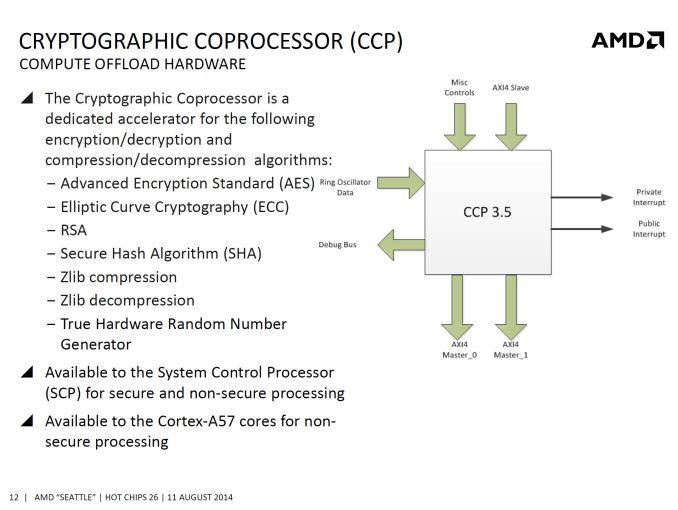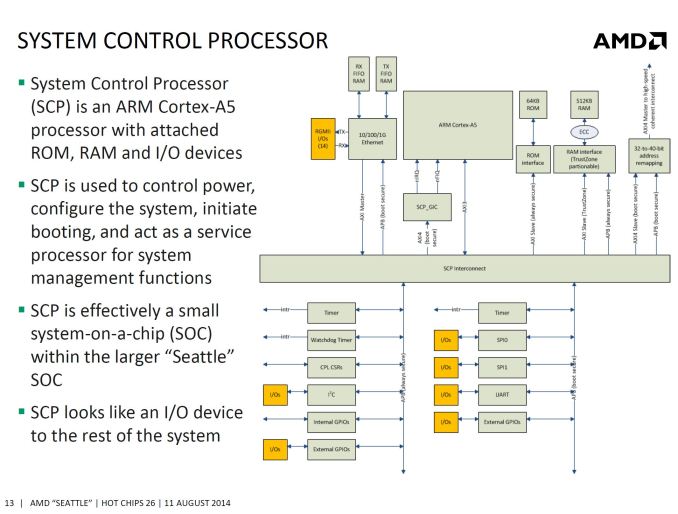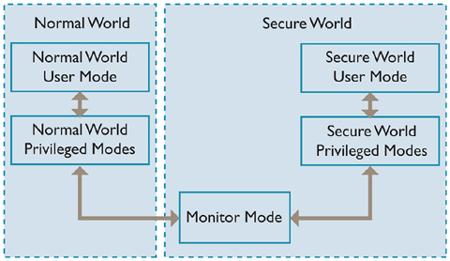AMD’s Big Bet on ARM Powered Servers: Opteron A1100 Revealed
by Stephen Barrett on August 11, 2014 12:00 PM EST- Posted in
- SoCs
- IT Computing
- AMD
- Arm
- Opteron
- server
- Enterprise CPUs
- Opteron A1100
AMD’s Special Sauce: A1100’s Co-Processors
This year, AMD has answered some critics of their business by describing their plans to regain a differentiated position on the market. One of the key slides AMD used to described its position showed ARM, GPU, and x86 cores at the center surrounded by complementary IP.
AMD’s argument is it is uniquely positioned as the only chip company with powerful graphics, ARM and x86 CPU designs, a server heritage including security and fabric (thanks SeaMicro), as well as extensive chip packaging, motherboard and server design expertise.
The complementary IP AMD brings to the A1100 is two Co-Processors. The Cryptographic CoProcessor (CCP) and the System Control Processor (SCP).
While the Cortex A57s include cryptographic instructions courtesy of the ARMv8 ISA, there are times when a server has significant cryptographic load and it is better to offload that to a coprocessor than service it directly on the CPU core. Cryptographic transactions such as https are well suited for the CPU core as they require low latency and the overhead to offload the work often negates the acceleration the coprocessor provides. However, cryptographic transactions such as archive compression/decompression and large data set encryption/decryption can benefit tremendously.
Utilizing the coprocessor requires operating system awareness to redirect cryptography functions to the dedicated hardware instead of doing them with the general purpose hardware. For example, requesting a random number from the OS would ideally fetch it from the CCP. AMD has already committed an update to the Linux 3.14 kernel to support this.
The SCP is based around an ARM Cortex-A5 processor and is effectively an SoC itself inside the A1100 SoC. The rest of the A1100 communicates to the SCP as if it is an IO device. This seems weird, but the isolation is by design. There are two reasons for this: Out-of-band management, and secure processing with ARM TrustZone technology.
Out-of-band management is a technique used in industry for servicing and diagnosing deployed systems regardless of the state of its normal operation or ‘in-band’ components. The SCP has its own dedicated 10/100/100 Ethernet connection, RAM, ROM, and IO connectivity. Connecting from a management interface, a user can read and configure motherboard devices like temperature sensors, power supplies, and fans completely independent from the rest of the A1100 SoC’s activities. Since the SCP is also core to the boot process, server administrators can also reset servers remotely.
One of the other reasons the SCP exists it to implement ARM's TrustZone technology. AMD announced two years ago they would be partnering with ARM to implement TrustZone technology into future CPUs, and this is the first server CPU to receive the feature. This processor is actually already present in AMD’s x86s APUs. To recap, TrustZone is an ARM technology providing a ‘secure world’ inside the SoC. Programming routines requiring utmost security, like digital rights management, can execute inside the SCP and are protected from unauthorized access from the ‘normal world’. These features are typically found in consumer devices, as certain applications like Netflix require a secure processing path to play HD content. AMD likely reused their TrustZone processor design from consumer APUs to implement the SCP, and it will be interesting to see how server software takes advantage of it.
















28 Comments
View All Comments
coburn_c - Tuesday, August 12, 2014 - link
Why are there no 28nm FX products. Why are there no micro atx/mini itx AM3+ boards. Why is AMD walking away from the performance market. Why would anyone buy ARM from AMD when their track record is to walk away from their customers?silverblue - Tuesday, August 12, 2014 - link
There's a lot of "why"s in your post. I doubt they have the money to create a new FX line right now (28nm SHP doesn't clock as highly as 32nm SOI anyway). Their performance CPU lines are not popular enough (and probably too power hungry) to warrant uATX/mITX.As for the last question, AMD have the market experience and are ahead of everybody else in bringing such a product to market. I doubt they'll have their own cake and eat it, but how they get on here will be a good indication for other ARM licensees as to what they can expect from releasing their own products. Besides, if you can't directly compete in traditional markets, you need to possess the agility to look for a market that you can compete in. That is kind of the point - in my eyes - to AMD hiring Rory Read in the first place, and should be answered over the next year.
atlantico - Tuesday, August 12, 2014 - link
AMD probably wants to make sure that the next FX they offer will be an unquestionably worthwhile upgrade. The FX line has been very good, in fact the FX8350 is still the best value chip available for purchase (though the FX8300 is a pretty good value too) - but the competition can offer better performance.Like when the Radeon HD7900 line was introduced, an extremely good value GPU, it still didn't perform as well as the competition and many were reluctant to give credit to that line - but the 7900 GCN chip was a beginning, like the FX8300 line is.
The next major iteration of the architecture must be a worthwhile step up, and I'm sure AMD can deliver on the CPU front as they did on the GPU front, but as the GCN refresh took time, the FX refresh will too.
It will ship when it is ready. AMD is here to stay.
beginner99 - Tuesday, August 12, 2014 - link
Still don't see the point of this. it's niche. Visualization on a full server cores is just as efficient and offers other advantages. Yes it might be cheaper but if the difference of CPU cost usually is negligible in servers running software that costs millions per year.easp - Tuesday, August 12, 2014 - link
If you don't see the point, then you are so far from the target market, you should just skip articles like this in the future.The primary market for this is for orgs that buy servers by the aisle (or data center), particularly those that own most of the software stack that runs on them.
Such people care a lot about power consumption. Balanced system architectures with a good balance between compute, memory bandwidth and I/O tend to be more efficient and can have capital cost advantages as well.
Ammohunt - Thursday, August 14, 2014 - link
Not for OS agnostic highly threaded workloads. I have a lot of backend tasks here where i work that could be offloaded to say a KVM based virtual environment running on ARM. Environmentals are expensive and large blade chassis put a lot of load them.eyours12 - Sunday, August 17, 2014 - link
Cool!cait@asomi.com - Thursday, August 28, 2014 - link
Is the cryptographic co-processor an OpenCL device, or is limited to specific cryptographic functionality. The latter would be a mistake. It takes an ARM design and makes it more like Intel CPUs rather than the approach AMD has been promoting.